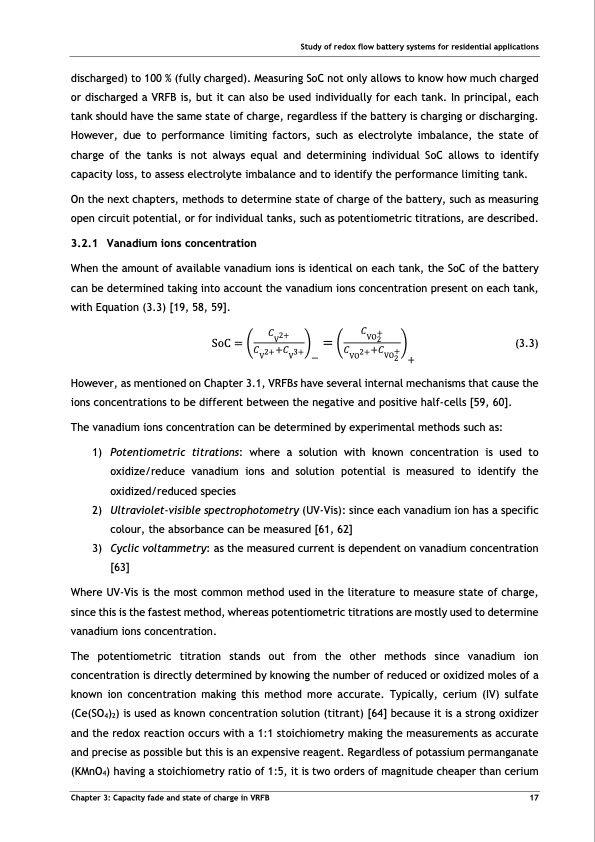
PDF Publication Title:
Text from PDF Page: 028
Study of redox flow battery systems for residential applications discharged) to 100 % (fully charged). Measuring SoC not only allows to know how much charged or discharged a VRFB is, but it can also be used individually for each tank. In principal, each tank should have the same state of charge, regardless if the battery is charging or discharging. However, due to performance limiting factors, such as electrolyte imbalance, the state of charge of the tanks is not always equal and determining individual SoC allows to identify capacity loss, to assess electrolyte imbalance and to identify the performance limiting tank. On the next chapters, methods to determine state of charge of the battery, such as measuring open circuit potential, or for individual tanks, such as potentiometric titrations, are described. 3.2.1 Vanadium ions concentration When the amount of available vanadium ions is identical on each tank, the SoC of the battery can be determined taking into account the vanadium ions concentration present on each tank, with Equation (3.3) [19, 58, 59]. 𝐶 2+ 𝐶VO+ SoC=( V )=( 2 ) (3.3) 𝐶V2+ +𝐶V3+ 𝐶VO2+ +𝐶VO+ −2+ However, as mentioned on Chapter 3.1, VRFBs have several internal mechanisms that cause the ions concentrations to be different between the negative and positive half-cells [59, 60]. The vanadium ions concentration can be determined by experimental methods such as: 1) Potentiometric titrations: where a solution with known concentration is used to oxidize/reduce vanadium ions and solution potential is measured to identify the oxidized/reduced species 2) Ultraviolet-visiblespectrophotometry(UV-Vis):sinceeachvanadiumionhasaspecific colour, the absorbance can be measured [61, 62] 3) Cyclicvoltammetry:asthemeasuredcurrentisdependentonvanadiumconcentration [63] Where UV-Vis is the most common method used in the literature to measure state of charge, since this is the fastest method, whereas potentiometric titrations are mostly used to determine vanadium ions concentration. The potentiometric titration stands out from the other methods since vanadium ion concentration is directly determined by knowing the number of reduced or oxidized moles of a known ion concentration making this method more accurate. Typically, cerium (IV) sulfate (Ce(SO4)2) is used as known concentration solution (titrant) [64] because it is a strong oxidizer and the redox reaction occurs with a 1:1 stoichiometry making the measurements as accurate and precise as possible but this is an expensive reagent. Regardless of potassium permanganate (KMnO4) having a stoichiometry ratio of 1:5, it is two orders of magnitude cheaper than cerium Chapter 3: Capacity fade and state of charge in VRFB 17PDF Image | Tubular Vanadium Air Redox‐flow battery

PDF Search Title:
Tubular Vanadium Air Redox‐flow batteryOriginal File Name Searched:
204521.pdfDIY PDF Search: Google It | Yahoo | Bing
Salgenx Redox Flow Battery Technology: Salt water flow battery technology with low cost and great energy density that can be used for power storage and thermal storage. Let us de-risk your production using our license. Our aqueous flow battery is less cost than Tesla Megapack and available faster. Redox flow battery. No membrane needed like with Vanadium, or Bromine. Salgenx flow battery
| CONTACT TEL: 608-238-6001 Email: greg@salgenx.com | RSS | AMP |